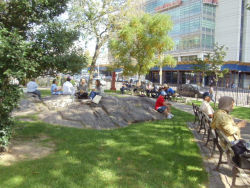Mitchel Square
Mitchel Square
Mitchel Square honors the memory of John Purroy Mitchel (1879-1918), the youngest mayor in the history of New York City, who was known for his uncompromising idealism and scrupulous honesty. Mitchel was born and raised in an Irish Catholic family in the Fordham section of the Bronx. His grandfather, John Mitchel, was a renowned writer and leader in the Irish independence movement. The younger Mitchel rose to prominence in 1906, just five years after his graduation from New York Law School, for leading the investigation of Manhattan Borough President John F. Ahern and Bronx Borough President Louis Haffen. Both of the Borough Presidents were ejected from their posts as a result of the investigation. The young politician’s reputation as a reformer garnered him the support of the anti-Tammany forces. In 1909, Mitchel was elected President of the Board of Alderman (an organization similar to the current City Council). Four years later, at the age of 34, Mitchel was elected Mayor.
Mitchel heeded the call of the First World War shortly after his four-year mayoral term ended and joined the Army aviation corps. On July 6, 1918, Mitchel fell 500 feet from his plane to the ground during a training flight in Lake Charles, Louisiana. He was killed instantly. New Yorkers responded to Mitchel’s death with a flurry of eulogies and memorials. An airfield in Long Island, now home to Hofstra University and Nassau Coliseum, was named in Mitchel’s honor. An elaborate memorial with a gilded bronze bust set in a two-level classical granite setting dedicated to Mitchel was erected in Central Park, at Fifth Avenue and 90th Street, where it still stands. On February 8, 1919, the Board of Alderman named this park for Mitchel.
The visual centerpiece of Mitchel Square is the Washington Heights-Inwood War Memorial, a striking bronze and granite group sculpture. Twenty inscribed bronze tablets listing the names of 357 local men killed during the war surround the base of the monument, alternating with images of torches. The monument was dedicated on May 30, 1923. The work was sculpted and donated by Gertrude Vanderbilt Whitney, who dedicated much of her career to sculpting scenes of World War I. This monument won Whitney a gold medal from the New York Society of Architects and she received the French Legion of Honor Medal for a work in St. Nazaire. Whitney also established Manhattan’s Whitney Museum.
Parks acquired this triangular property, bounded by West 166th Street, Broadway, and Audubon Avenue, in 1908, and dedicated it as a public space in 1911. Originally, the property consisted of two triangular patches of land. In 1943, when the park’s jurisdiction was transferred from the Board of Estimate to Parks, city designers unified the two sections.
Mitchel Square features several benches surrounded by trees and shrubbery. A major 1998 reconstruction funded by Council Member Guillermo Linares included landscaping and the installation of a black wrought-iron fence and new benches. In 1999, the sculpture and base of the war memorial were cleaned, the patina replaced, protective coating applied, and a damaged bayonet was restored. Theodore Roosevelt (1858-1919), 26th President of the United States, wrote of this park’s namesake, “No stauncher American, no abler and more disinterested public servant, and no finer natural soldier than Purroy Mitchel was to be found in all our country.”
Check out your park's Vital Signs
Clean & Safe
Green & Resilient
Empowered & Engaged Users
Share your feedback or learn more about how this park is part of a
Vital Park System




